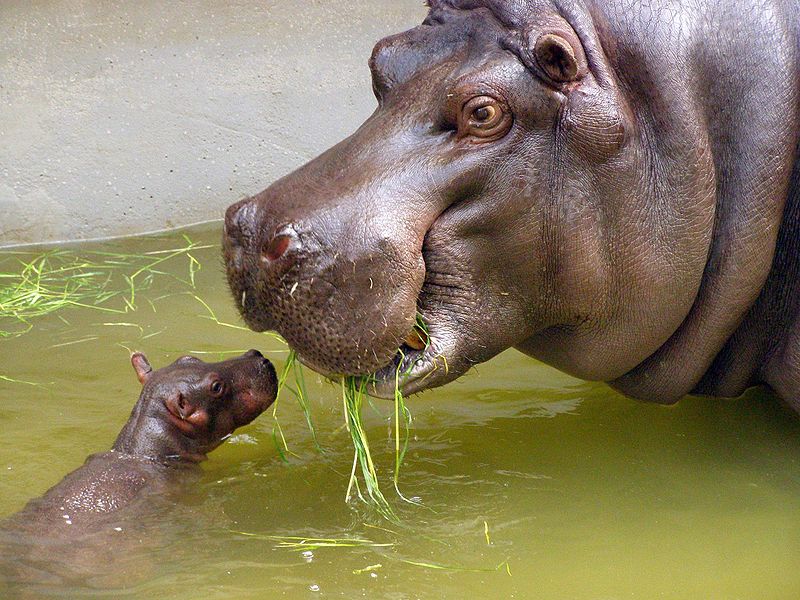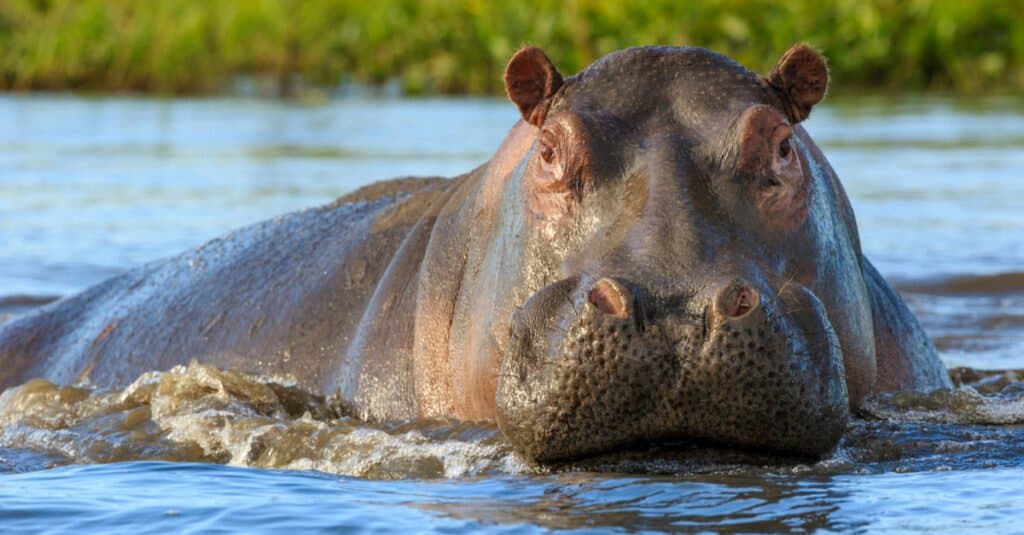The hippopotamus is one of the most powerful animals on the planet. Hippos are the third-largest land animals and are native to Africa. When many of us think of hippos, we imagine a big gray blob hanging out in the water and relaxing in the sun. However, you might be surprised to find out that hippos are actually far more interesting than we may have initially assumed.
The hippopotamus is a semi-aquatic mammal native to Africa. It is one of only two species in the Hippopotamidae family, the other being the common or river hippo and the pygmy hippo. The river hippo is the larger of the two, with the majority of its population situated in Sub-Saharan Africa.

The common hippo, along with the elephant and rhinoceros, is one of the largest creatures on the globe. A full-grown male can weigh up to 7,000 pounds. A female hippo will typically weigh around 3,000 pounds.
Hippos live in rivers, lakes, and mangrove swamps, where territorial males rule over stretches of water and herds of five to thirty cows and calves. While you will almost always encounter hippos in the water, they actually cannot swim or float. However, hippos can hold their breath for up to 5 minutes. That’s ample time to wander along the lake and riverbed bottoms. Often, only their eyes will be visible, but they will always stay in shallow water during their time in rivers and lakes.

How Long Do Hippos Live?
The average hippo’s lifespan is 40-50 years. Donna the hippo was once one of the oldest captive hippos. She died in 2012, at the age of 61, at the Mesker Park Zoo in Evansville, Indiana, in the United States. Bertha, the oldest known hippo, has lived at the Manila Zoo in the Philippines since it opened in 1959. Her age was reported to be 65 when she died in 2017.
As we can see, the lifespan of hippos greatly increases when they are living in captivity in comparison to life in the wild. This is because, in captivity, they don’t have to deal with as many external threats or forage for their food. With all of this knowledge on the hippo lifespan, let’s jump into their amazing life cycle.
The Average Hippo Life Cycle
Birth
The hippo’s gestation period is around eight months. Baby hippos weigh between 25 and 50 kg (55 and 110 lbs) when they are born in the water. To take their first breath, they must swim to the surface. The mother usually only gives birth to one calf. However, they can give birth to twins sometimes. At about three weeks, hippos will finally stop nursing and begin to eat grass. Soon after giving birth, the mother and child join hippo schools that offer some protection from crocodiles, lions, and hyenas.
Calves
Hippo calves will never stray far from their mothers. They may feed and even play all on their own. However, they will still always come back to their mother. In fact, hippos do not leave their mothers until they are completely mature, which is around the age of 7-8 years. When the baby hippos are old enough, their mother will teach them to swim. Baby hippos can only stay underwater for a half minute. Mother hippos must safeguard their offspring from male hippos as well. Grown males do not attack the babies on land, but they will attack and frequently kill newborn hippos in the water.
Adulthood
As the babies grow into adults, the females are ready to mate as young as three or four years old, but usually not until they are five or six years old. Males develop more slowly and are ready to breed at around 7.5 years old. This is the age when they will finally leave their mother. Boy hippos frequently find a flock of hippos that has just lost its leader and take over as the group’s leader. The girls, on the other hand, will join their mate pack.
Factors That Impact The Hippo Lifespan

The Hippopotamus population has been falling over the previous ten years for a number of causes. Though the IUCN Red Categorize does not list these animals as endangered, pygmy hippos are considered endangered, while common hippos are classed as vulnerable. According to the IUCN, between 115,000 and 130,000 common hippos are left in the wild.
Let’s take a look at some of the biggest factors that impact the hippo’s lifespan:
Hunting: Hippo poaching for their ivory canine teeth and flesh is one of the most serious threats to their existence. Both species have large lower canine incisors, which attract illicit hunting and trapping in addition to their meat. Humans eat both the common and pygmy hippos and use their skins to make jewelry and other goods.
Habitat loss: Large-scale construction near wetland regions, as well as water diversion for agricultural uses, have resulted in severe habitat loss for hippos. In order to keep its hide moist, the amphibious common hippo needs access to a permanent body of water. When droughts and development obliterate rivers and lakes, it faces additional obstacles.
Human conflicts: Every year, hundreds of hippos are killed to reduce human-wildlife conflict. The destruction of wetlands and woods to make way for farming and houses often forces both species to graze on human-occupied lands. To protect their land, farmers have been known to kill hippos.





.png)
Comments
Post a Comment